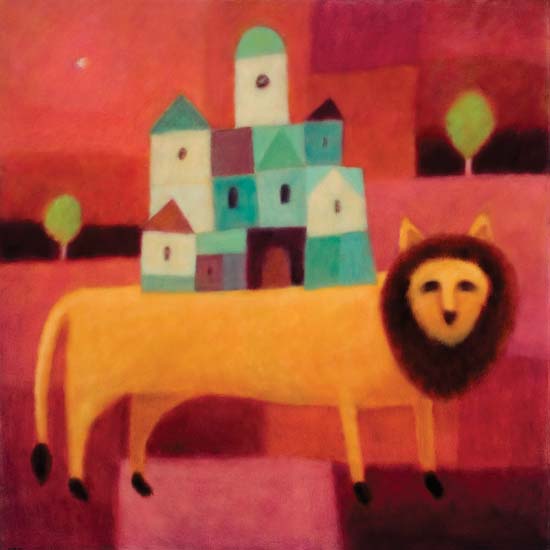
“One of the projects of art is to reconcile us with the world, not by protest, irony or political metaphors but by quiet contemplation… to offer us a glimpse of a universe into which we can move without strain. It is not the world as it is, but as our starved senses desire it to be: neither hostile nor indifferent, but full of meaning.” Robert Hughes
In a pageant of shimmering colour, Nick Howson chronicles the fabled events of times past and present. Many of the works reference memories of a journey he made through ancient lands and the art treasures encountered there. The awe and inspiration Howson derived from seeing firsthand, the architectural marvels and their stained-glass windows, mosaics and medieval icons remain undiminished to this day. Places closer to his home in Melbourne, as well as the unexpected beauty of Australia’s hazy, bleached landscapes also continue to provide bountiful stimuli.The painting Calling, heralds what may be discovered by ‘quiet contemplation’ of Howson’s art. Manifesting amidst richly variegated fields, an emblematic bird – its beak wide open – supplicates some unseen creative force. Laden with inherent symbolism, Kingdom is the most vibrantly coloured piece. Against a sumptuous crimson ground, a mighty lion pauses and directly regards the viewer. “King of the beasts”, the lion is associated with royalty, victory, dominion and the embodiment of not only earthly power but messianic, spiritual power as well. This lion carries on his back the “Celestial City” or Kingdom to come.
Howson’s portrayal of the Madonna and Child has a similarly equivocal context. In patterns over patterns, the figures merge with and materialise from the Arcardian scene. The throne or ‘seat of wisdom’ upon which she sits, and the garden setting, recall Mediaeval depictions of the Virgin. In those times, meditation retreats called ‘Mary Gardens’ represented the Paradise that had been lost and a sanctuary where the soul could be cultivated. Here, in the Madonna and Child garden, the same two trees that appear in Calling and Kingdom once again stand verdant with new life. Howson has placed a rose in the Madonna’s hand to complete the symbolic idyll.
In other works, two riders traverse different centuries and lands to present the ‘Word’ by very different means. Across a red terrain the Crusader gallops on a curiously jade-coloured steed. Proud and purposeful, with the flag of the French Crusaders streaming aloft, he is markedly distinct and apart from his surrounds. The image of Mary MacKillop is altogether less bold. Seated demurely in sidesaddle position, she is on a gentler mission. Howson’s interest in the recently canonised saint was kindled when learning that Mary MacKillop was born in nearby Fitzroy and that she had reputedly made teaching expeditions to NW Victoria – an area he has often visited. The piece also offers a subtle linking to the rest of the paintings in the exhibition where the simple, visual elements of Australian town and country life are explored.
Although allegory and history inform the imagery, narrative has never been his primary focus. Howson’s concern lies more in using them as vehicles for abstract investigations into colour value and pictorial structure. The scumbling of multiple layers of oil pigment into coarsely textured Belgium linen creates Howson’s signature, indefinite atmospheres. By employing the flat, two-dimensional format of ancient and mediaeval art forms, all extraneous detail is pared away leaving the viewer free to respond to compositional and colour relationships. Calm, hieratic and luminous, Howson’s paintings project an untroubled sense of wholeness. They “offer us a glimpse of a universe into which we can move without strain.” Masterful reflections of order, his works have all the dignity, meaning and permanence of the classical and mediaeval artforms that inspired them.
Receive e-mail updates on our exhibitions, events and more
Subscribe Now